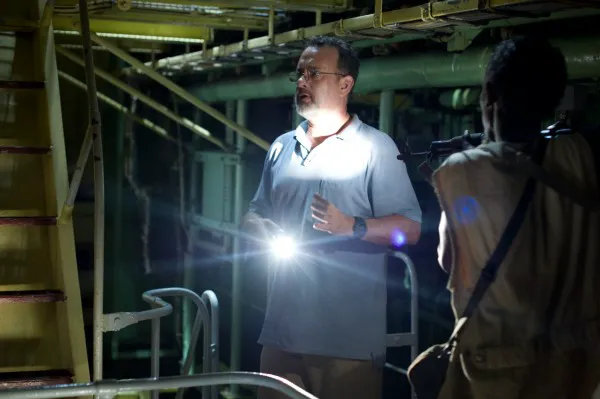Captain Phillips: A Tale of Piracy and American Heroism
Captain Richard Phillips (Tom Hanks) commands the Maersk Alabama, a container ship en route from Oman to Kenya. As the ship navigates the waters off the coast of Somalia, it becomes the target of pirates, former fishermen led by Muse (Barkhad Abdi). Initially, the crew manages to fend off the attackers, but the Somali pirates eventually board the vessel. Their goal is to force Phillips and his crew to sail closer to the coast, with the intention of demanding a $10 million ransom from the shipping company. As the captain struggles to prevent a complete takeover of the ship, American warships race to the Maersk Alabama’s rescue.

Somali fishermen turned to piracy after foreign trawlers depleted their traditional fishing grounds.
From Political Commentary to Patriotic Tribute
Remember how, in 2010, British director Paul Greengrass released the war thriller “Green Zone,” which directly accused the American military of falsifying reports about the presence of weapons of mass destruction in Iraq? American audiences didn’t take kindly to that film, despite the fact that Matt Damon played the lead role. “Green Zone” was so poorly received by Western audiences that it didn’t even recoup its $100 million budget at the global box office. As they say, think before you bite the hand that feeds you!

Much of the film was shot at sea. Cinematographer Barry Ackroyd battled constant bouts of seasickness during the production.
A Shift in Perspective
Well, Greengrass seems to have learned his lesson. His new film doesn’t “attack” the Pentagon; instead, it celebrates the valiant American army and the equally valiant Stars and Stripes navy. Look at those broad-shouldered special forces! Look at those unflappable officers! Look at those powerful ships! Look at those useful “drones”! And all of this is not for clearing out some unknown Pakistani village, but for the sake of man and for the good of man. Moreover, a very specific man with an American name. Hold on, Captain Phillips, help is on the way! We have two snipers for every Somali, and they are so cool that they parachute into the ocean in complete darkness and then brilliantly carry out the White House’s mission (because if an American is in trouble anywhere in the world, the President of the United States will not sleep peacefully until he saves his fellow citizen). Are some liberals wondering why America spends more on its military than anyone else in the world? Paul Greengrass is ready to give a full-length lecture on what that money goes towards and how effectively it is used.

A Gripping Thriller Turned Patriotic Showcase
Admittedly, in its first half, “Captain Phillips” doesn’t feel like a hymn to the American Navy. Viewers first get a glimpse into Phillips’ home life, then sail with him on the container ship, which is quite interesting – it’s not every day that we see how merchant sailors live and work! Then, pirates appear on the horizon, the plot picks up speed, and the film becomes not only interesting but also gripping. Especially when the Somalis with their Kalashnikovs board the ship, and the unarmed crew plays a deadly game of cat and mouse with them. If the film had limited itself to this, Greengrass would have created a powerful thriller.
But “Captain Phillips,” based on a true story and following the facts quite closely, doesn’t stop there. After the first hour, warships enter the picture, the main character is left alone with four pirates in a small lifeboat, and the film essentially ends there. What follows is pure advertising for the valiant military, completely devoid of drama. Why? Because the pirates can’t kill their only hostage, and the special forces can’t let the pirates go back to Somalia. So, there can only be one outcome to the mission – Phillips will be freed (after all, he’s the main character!), and the villains will either be killed or captured alive. All that remains is to wait impatiently for the end of the operation and admire the coordination and professionalism of the “Navy SEALs.” One could, of course, feel sorry for Muse and his comrades, who have valid reasons for seizing foreign ships. But it’s hard to sympathize with drug-addled pirates. Evil is evil. And although Tom Hanks, it must be admitted, gives a magnificent, heart-wrenching performance as an “ordinary hero” who tries to keep himself together in the face of mortal danger, the film’s plot doesn’t support his performance; it negates it. Because the hero may not know what will happen next, but the audience knows perfectly well. If they know anything about Hollywood films.